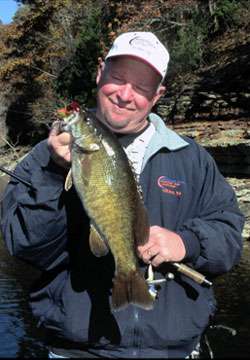
When most bass anglers think about the Carolina rig, they think about largemouth bass. Green fish are the ones that are usually targeted with the old "ball and chain."
But it certainly doesn't have to be that way. Plenty of brown bass can be caught on a Carolina rig, and fall is one of the best times to do it.
I typically use a Carolina rig in situations where the bass are too deep to be reached by a crankbait and when fishing a jig at that depth would be too slow when you're searching for fish.
You can really cover a lot of water pretty fast with a Carolina rig. If I were to use a jig under the same circumstances, it would take a lot longer to cover the same area because the jig would be lighter and I wouldn't be able to move it as fast and still stay in contact with the bottom.
My Carolina rig usually consists of a 3/4-ounce sinker (I use lead most of the time because it's cheaper than tungsten and I lose a lot of sinkers!), an 8 millimeter glass bead, a swivel and a 3- or 4-foot leader that's made up of 6- or 8-pound-test fluorocarbon line.
That's right, I use really light line on my leader. After all, I'm usually fishing in clear water and the lighter leader means more strikes. It also means more break-offs, but I'll trade the break-offs for the strikes. If the water's a little dingy, I'll bulk up to 10- or 12-pound line.
My main line is 14- or 17-pound test fluorocarbon — a lot heavier than my leader. It helps me a good hook-set even in deep water and helps to ensure that the leader breaks rather than the main line.
I fish it on a 7-foot All Pro casting rod and Shimano Curado. You want a long rod so you can make a long cast and move a lot of line on your hook-set.
Now to the part you really want to know about — the lure.
My favorite Carolina rig bait is a 3 1/2-inch tube made by Kamikaze Bait Company called the Hitzit. I fish it weightless on a 3/0 or 4/0 Gamakatsu Extra Wide Gap hook.
That tube might look like a crawfish to the bass, or it might look like some sort of little baitfish, but at that size and in that color it definitely looks like something to eat. I have a lot of confidence in it.
Every once in a while, I'll use a 3/4-ounce jig in place of the Carolina rig sinker. It works about as well as the sinker (though it doesn't sink as fast, and you'll have to work it a little more slowly) and sometimes the bass will hit the jig when they won't eat the tube.
One of the things you need to remember about fall smallmouths is that they're almost always schooling. If you catch one, you can be pretty sure there are others in the area. Just keep working the Carolina rig through that area until you catch a few more. Then switch over to a jig and really clean up.





